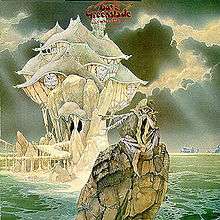Cactus Choir
Cactus Choir is the first solo album by British keyboardist Dave Greenslade, released in 1976 soon after the disbandment of his own eponymous band, Greenslade.[1] His Greenslade bandmate Tony Reeves also plays on half of the album's tracks. The artwork for the cover is by Roger Dean.
| Cactus Choir | ||||
|---|---|---|---|---|
 | ||||
| Studio album by | ||||
| Released | 1976 | |||
| Genre | Progressive rock | |||
| Length | 41:36 | |||
| Label | Warner Bros. (UK) | |||
| Producer | Gregg Jackman, Dave Greenslade, Rupert Hine | |||
| Dave Greenslade chronology | ||||
| ||||
| Review scores | |
|---|---|
| Source | Rating |
| Allmusic | |
Track listing
All music written by Dave Greenslade. Lyrics written by Jon Hiseman (2) and Martin Hall (4, 6b).
- Side one
- "Pedro's Party" - 2:38
- "Gettysburg" - 3:58
- "Swings and Roundabouts" - 4:19
- "Time Takes My Time" - 6:00
- "Forever and Ever" - 4:06
- Side two
- "Cactus Choir" - 6:15
- a)"The Rider" - 2:52
- b)"Greeley and the Rest" - 2:01
- c)"March at Sunset" - 1:22
- "Country Dance" - 5:36
- "Finale" - 8:37
- "Gangsters (2014 reissue bonus track)" - 2:56
Personnel
- Dave Greenslade — keyboards, lead vocal (4), vibraphone (5, 6, 8), handclaps (1), percussion (3), co-producer
- Tony Reeves — bass guitar (1, 2, 6, 8)
- Simon Phillips — drums, percussion (1, 3)
- Steve Gould — lead and backing vocals (2, 6)
- Dave Markee — bass guitar (3, 4), percussion (3)
- John G. Perry — bass guitar (7)
- Mick Grabham — guitar (4)
- Lissa Gray — backing vocal (4)
- Bill Jackman — bass flute (8), bass clarinet (8)
- Gregg Jackman — co-producer, engineer, handclaps (1)
- Rupert Hine — co-producer, handclaps (1)
- Chris Tsangarides, Martin Moss - assistant engineers
- Simon Jeffes — orchestra arranger
- Martin Ford — orchestra conductor
gollark: ÆÆÆÆÆÆÆÆÆÆA
gollark: DON'T DESCRIBE SCP-3125
gollark: japanese people are peoplesome of them are weirdlike with most groups of people
gollark: I don't know the temperature here because the only temperature measurement I have is various computer systems' internal temperature monitoring.
gollark: ++delete walls
This article is issued from Wikipedia. The text is licensed under Creative Commons - Attribution - Sharealike. Additional terms may apply for the media files.